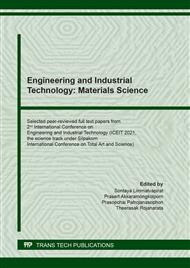p.81
p.87
p.93
p.99
p.105
p.111
p.117
p.123
p.129
Determination of Antimicrobial Activity from Various Plant Parts of Typha angustifolia Using Agar Disc Diffusion and Bioautography
Abstract:
Fruit, leaf, fruit stalk, and rhizome of Typha angustifolia, which is abundantly available in Thailand, were investigated for antimicrobial activities. The results showed that fruit ethanolic extract had high activity against Staphylococcus aureus and Bacillus subtilis similar to the fruit stalk and rhizome extracts whereas the lowest antibacterial activities was found in the leaf extract. Only rhizome extract had antifungal activity against Candida albicans. The fruit extract was chosen for furthur study because of its antibacterial action, ease of collecting, and preparation before usage. This fruit ethanolic extract was semi-purified by partition with petroleum ether, chloroform and ethylacetate, respectively and subsequently tested for antimicrobial activities by disc diffusion against S. aureus, Staphylococcus epidermidis, Sarcina lutea, Streptococcus faecalis, Streptococcus pneumoniae, Micrococcus flavus, Bacillus cereus, Bacillus pumillus, B. subtilis, Shigella somnei, Proteus mirabilis, Proteus valgalis, Alcaligenes fecalis, Serratia marcescens, Salmonella paratyphi A, Salmonella typhi, Escherechia coli, Pseudomonas aeruginosa, and Saccharomyces cerevisiae. The inhibitory zone against gram-positive bacteria was broader in all partitioned fractions than in gram-negative bacteria and yeast. Furthermore, none of the fractions were able to prevent the development of S. marcescens, P. aeruginosa, or E. coli. The inhibition zone of the ethyl acetate fraction was larger than that of chloroform and petroleum ether. In comparison to the other fractions, the chloroform fraction demonstrated the broadest inhibition zone against B. subtilis. Based on the bioautography investigation, it was reasonable to conclude that there were at least five antibacterial chemicals against B. subtilis. Therefore, fruit of T. angustifolia has the potential for use in the discovery of new antibacterial agents.
Info:
Periodical:
Pages:
105-110
Citation:
Online since:
March 2022
Authors:
Price:
Сopyright:
© 2022 Trans Tech Publications Ltd. All Rights Reserved
Share:
Citation:


